Learning from our Closest Relatives
An Emory anthropologist follows in the footsteps of Jane Goodall and the chimpanzees the famed naturalist began studying 60 years ago
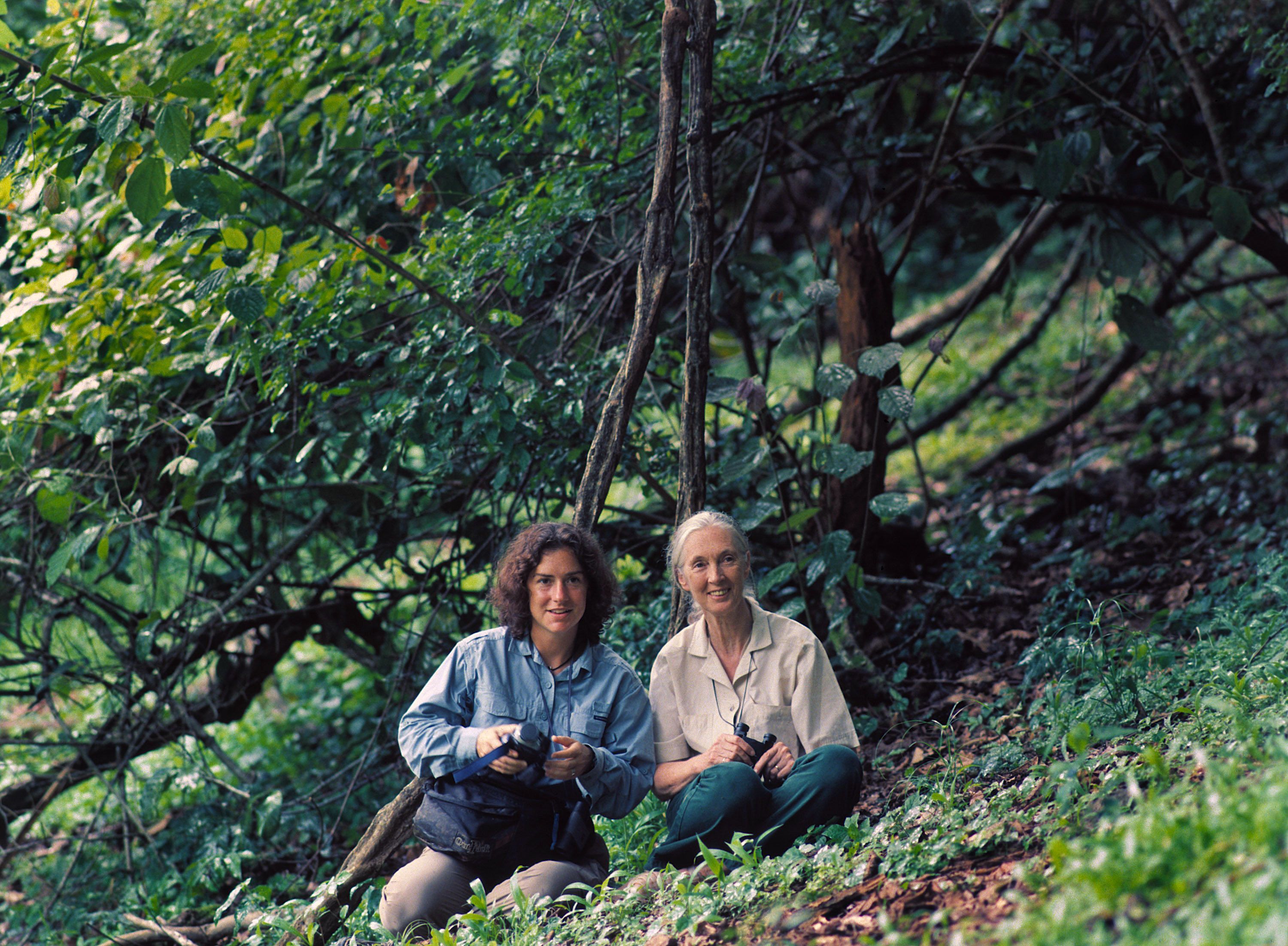
“Sometimes I’ll be in the forest and it will hit me that I’m so lucky,” says Elizabeth Lonsdorf, professor of anthropology at Emory University. “I’ll be taken aback that I’m in Gombe Stream National Park, a place with such a rich history, documenting the lives of the wild creatures who are most like us on the planet.”
It was Jane Goodall who introduced the forests of Gombe to the global community. She was just 26 when she traveled from her native England to Tanzania in 1960 to study the behavior of the chimpanzees at Gombe. Her observations of human-like behaviors, and documentary coverage of her extraordinary work, made her into one of the world’s most famous naturalists.
It also turned many of the chimpanzees into household names. They were no longer anonymous animals in a distant forest. They were individuals with personalities that connected us with the animal kingdom in ways that only our closest relatives could.
Watch a video explaining Jane Goodall's discovery of chimpanzees using tools.
In 1977, the Jane Goodall Institute formed to support the research at Gombe and protect the chimpanzees and their habitats.
Emory first became connected to the institute in 2008, when Thomas Gillespie, associate professor in the Department of Environmental Sciences, joined the faculty. Gillespie is a disease ecologist with projects in Gombe.
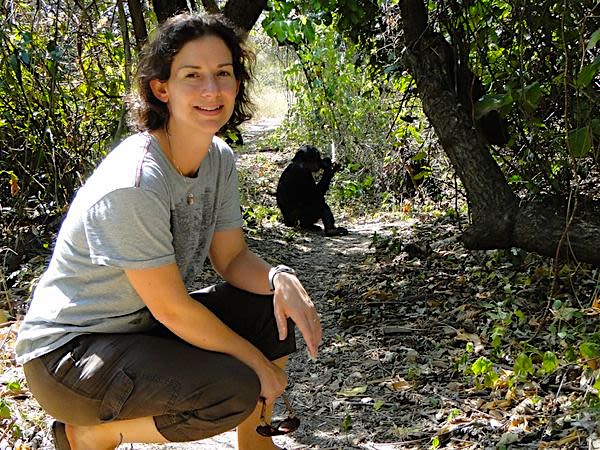
"I knew that I wanted to study smart, social animals," says Lonsdorf, describing her path to primatology. She is shown with a chimpanzee named Fudge, who had wandered near the staff camp at Gombe.
"I knew that I wanted to study smart, social animals," says Lonsdorf, describing her path to primatology. She is shown with a chimpanzee named Fudge, who had wandered near the staff camp at Gombe.
Lonsdorf joined the Emory faculty in the fall of 2022, strengthening and expanding the university’s ties to Gombe and the Jane Goodall Institute. Lonsdorf and Gillespie serve as co-directors of the Gombe Ecosystem Health Project. Lonsdorf is also co-director of the Gombe Mother-Infant Project.
She began working with Goodall in 1998 as a PhD student studying tool use by the Gombe chimpanzees. Lonsdorf has returned to Gombe every year since to maintain a research program focused on chimpanzee health and development.
In the following Q&A, Lonsdorf describes her career path to studying some of the world’s most charismatic animals.
"I went from studying the weirdest primate to studying the primate that's most like us."

What got you interested in primatology?
I was an 80s kid and grew up watching “L.A. Law” so I always thought I’d be a lawyer. Then I graduated from high school in 1992 and enrolled at Duke University, where they have a pre-orientation program called “Project Wild.” I realized that I really liked to be outside.
My original major was psychology and I gravitated towards the courses in animal behavior. One of these courses was taught by Carl Erickson, who did research at the Duke Lemur Center on a really cool lemur called the aye-aye, one of the most unique of the primates. I asked if I could get involved in his research and he agreed to let me help with aye-aye observations.
My first day at the lemur center, he told me, “I’m going to open this door and it’s going to be very dark except for a red light. I want you to sit and write down what you see.”
I assumed there would be an observation room and the aye-aye would be behind glass. Instead, I sit down and this creepy crawler comes out of the eerie red gloom and starts sniffing me. I loved it! I mean, who doesn’t love watching animals?
The aye-aye has ever-growing rodent teeth and this long middle finger. It uses the finger as a percussive foraging device and fishing wand. It taps on trees and then pokes the finger inside to get at grubs to eat. We were studying how they acquired these skills, how much of it is innate and how much is learned behavior.
Eventually, that same professor convinced me to add a second major in biology. I was hesitant because I actually failed my first biology test, which was all memorization. But I did much better in my field biology, animal behavior and ecology courses.
When I was a senior, I stood in line to meet Jane Goodall to get one of her books signed. While she signed my copy I just stood there grinning like an idiot. I was overwhelmed in the presence of someone I really admired. My mother was with me and said, “I’ve never seen you speechless.”
It was pretty clear at that point that I wasn’t going to be a lawyer.
How did you decide on a graduate school?
I knew that I wanted to study smart, social animals — whales, dolphins, elephants or primates. I applied to several different programs and I got accepted by the Jane Goodall Institute’s Center for Primate Studies at the University of Minnesota.
I didn’t think I’d wind up in Minnesota because I hate the cold — I mean, I really hate it — but it was too good of an opportunity. I went from studying the weirdest primate to studying the primate that’s most like us.
I focused my dissertation on how the Gombe chimpanzees develop tool-use skills. They are almost comically bad at it as infants and the skills are socially leaned over several years.
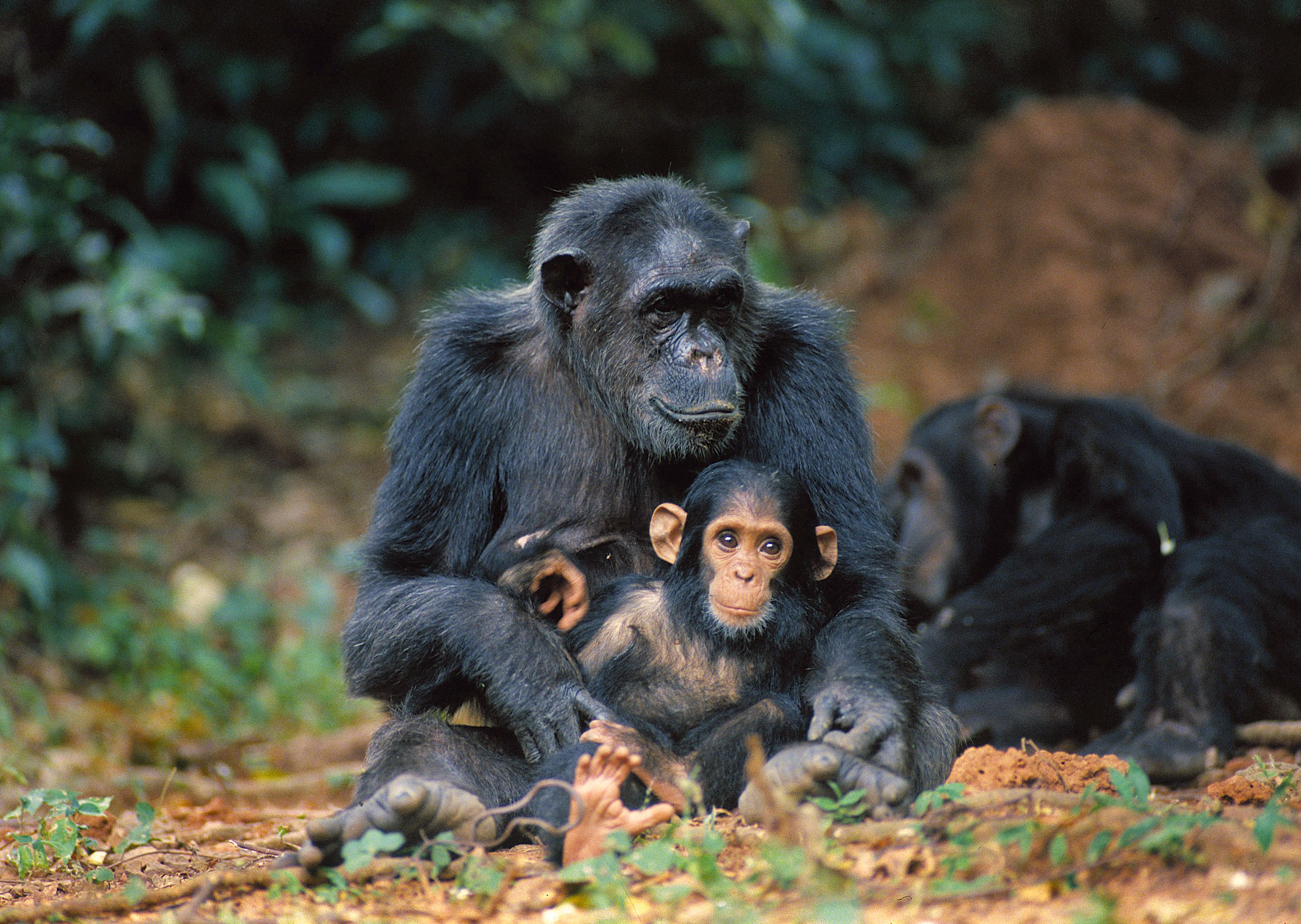
Do you remember your first encounters with chimpanzees at Gombe?
Vividly. My first day in the forest I encountered Fifi playing airplane with her daughter, Flirt. Jane had written about Flo playing airplane with her daughter, Fifi, laying on her back and holding the little one up with her legs. And now Fifi was grown up and playing in the same way with her daughter.
I sat down on the grass and was totally gobsmacked. It just resonated so strongly how much like us they are.
Fifi looked over at me and held my eye, as if to say, “You’re new here. Who are you?”
That knocked the breath out of me, to share this long look with a wild animal.
Watch a video of Fifi interacting with her children.
Another impactful memory from my first summer at Gombe was encountering a female named Gremlin and her newborn twins, Golden and Glitter. They were the cutest stinking things I’d even seen.
Chimpanzee twins are extremely rare and don’t usually survive in the wild. Typically, one is bigger and thrives while the other one does not. Not only did these twins both make it, they’re both mothers now. I’ve known them that long. I can watch these chimpanzees I knew as babies mother their own babies. So the Gremlin family is very special to me.
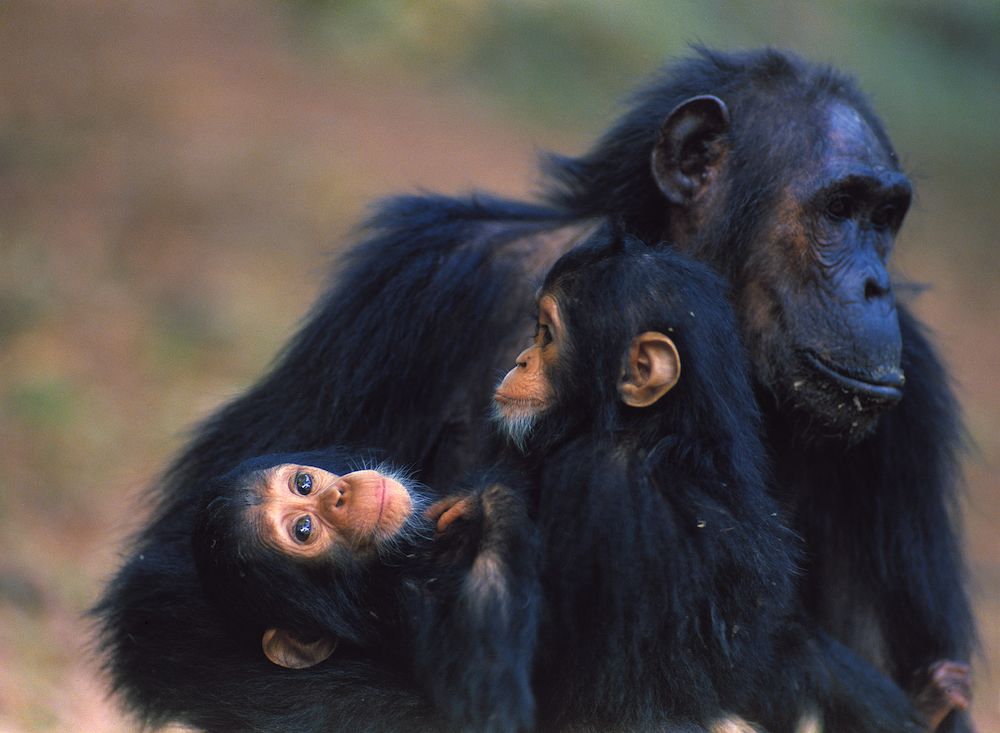
Gremlin with her twins Golden and Glitter. (Photo by Science Museum of Minnesota)
Gremlin with her twins Golden and Glitter. (Photo by Science Museum of Minnesota)
What fascinates you about the mother-child bond in chimpanzees?
Chimpanzees have a promiscuous mating system and fathers are not involved in child-rearing. Chimpanzees are the ultimate single moms. They continue to bear children throughout their lives and some of the Gombe chimpanzees are in their 50s.
Juvenile chimpanzees wean at about five years. They are still socially dependent and stay with their moms for another five years after that. Only wild primates, humans, some of the whales and dolphins, and elephants have a prolonged period of postweaning dependence for juveniles.
Jane Goodall wrote in her books about the relationships between mothers and infants and how differing mothering styles seem to grow different kinds of kids with differing outcomes. As co-director of the Gombe Mother-Infant Project, one focus of my research is understanding how baby chimpanzees grow up and how mothering may help or hinder that.
Chimpanzee mothers and juveniles are interesting in their own right, but it’s also interesting to think about what they can teach us about our ancestry. Another focus of my research is understanding the interplay of development and health in nonhuman primate behavior as a model for the evolution of human childhood.
Has studying the behavior of chimpanzee mothers and their children changed how you behave with your own children?
It’s definitely had an impact. I have two children, ages 17 and 13. I was very influenced by Gremlin and Fifi as examples of good moms to emulate. And Patty as not such a good mom.
Patty was kind of distant with her offspring; not very patient or attentive.
Gremlin is our oldest mom, at age 52, and very patient and attentive.
And Fifi gave her kids a lot of room to roam, but she noticed when they got into real trouble and rushed to intervene. She struck a balance between letting her kids learn on their own and assisting them when they really needed it.
I’m not always as patient as I’d like but I aspire to be more like Fifi as a mom.
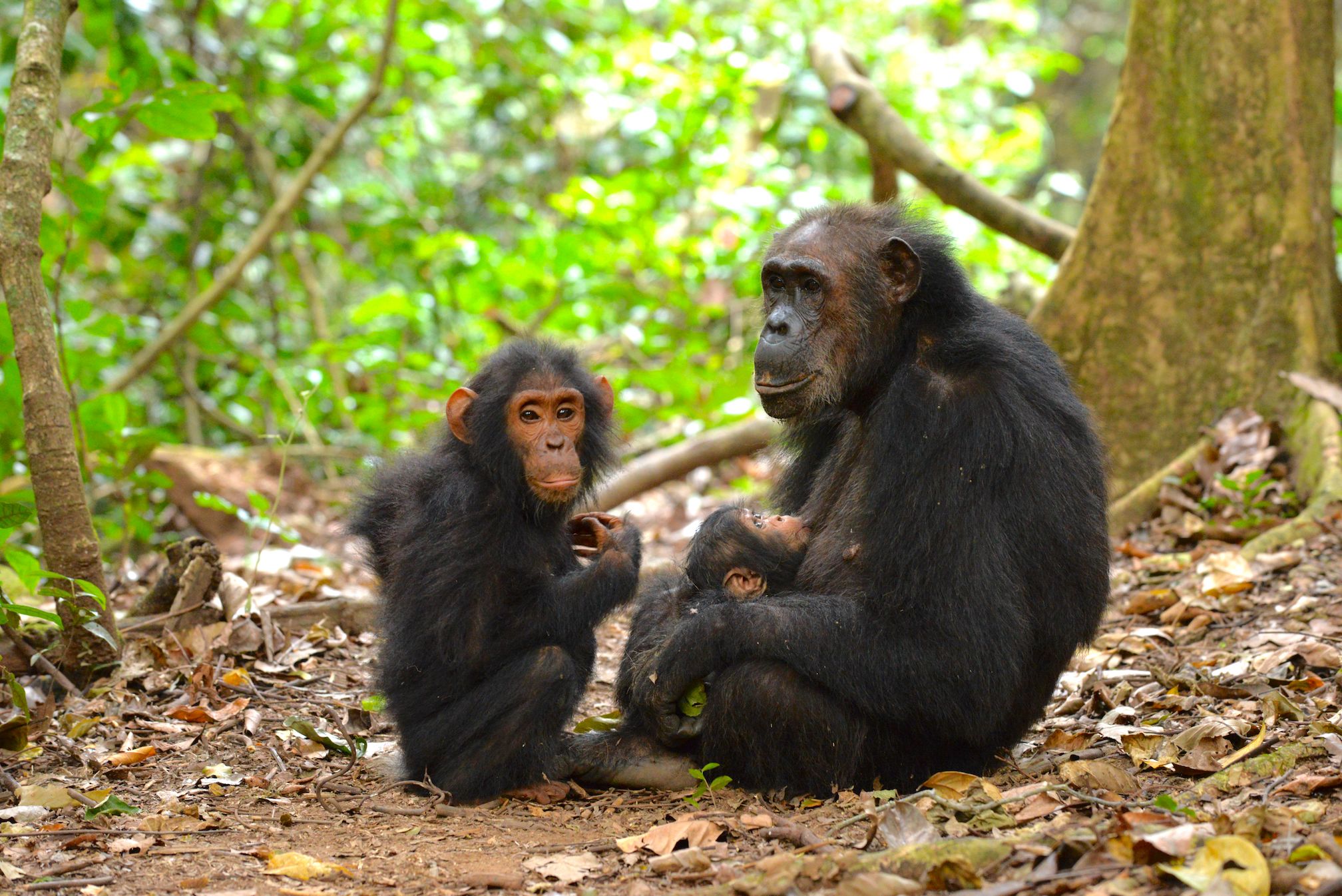
What’s it like to hang out with Jane Goodall?
Being able to walk in the forest with her and see chimpanzees is pretty awesome. It’s not something I ever imagined I’d be doing when I watched documentaries of her while growing up. She is an aspirational figure who still works 24/7 to improve the lives of people, animals and the environment.
She has a house in Gombe and I’ve gotten to stay there with her. She’s an incredible storyteller and has this very dry British wit. She can tell a good joke.
It’s been fun to go from someone who couldn’t speak in her presence to someone I can laugh out loud with.
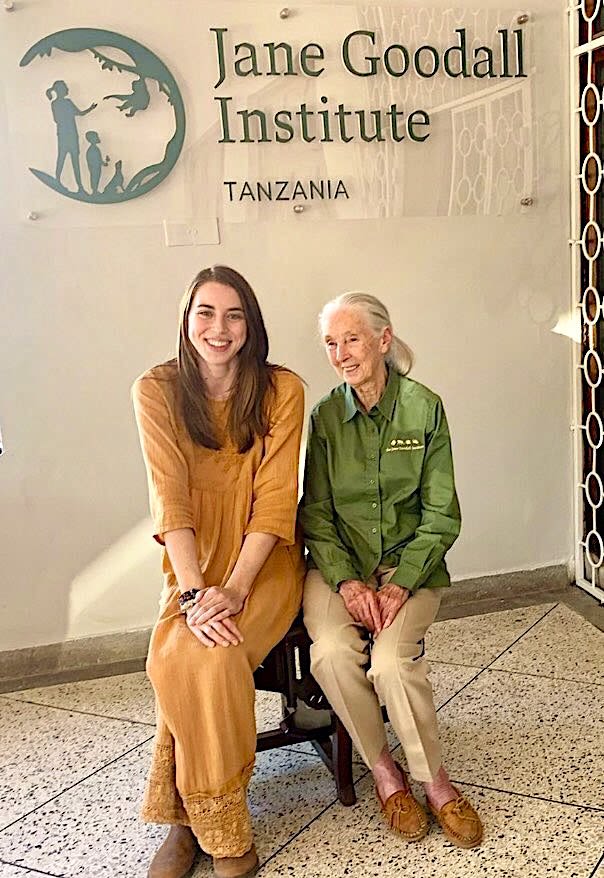
Emory graduate student Caroline Olson met Jane Goodall last summer when she traveled to Gombe to assist with a One Health needs assessment — a holistic view of the health of people, domesticated animals and wildlife. The work was funded by the Jane Goodall Institute and the Emory Global Health Institute. Olson is a PhD candidate in the Environmental Health Sciences Program at Rollins School of Public Health.
Emory graduate student Caroline Olson met Jane Goodall last summer when she traveled to Gombe to assist with a One Health needs assessment — a holistic view of the health of people, domesticated animals and wildlife. The work was funded by the Jane Goodall Institute and the Emory Global Health Institute. Olson is a PhD candidate in the Environmental Health Sciences Program at Rollins School of Public Health.
How has the research at Gombe evolved through the decades?
Jane Goodall has been collecting data since 1960, so we have this incredible store of information following a population of chimpanzees.
In addition to recording their behaviors, Jane documented any illnesses of individual chimpanzees that she observed. In 2004, the Gombe Ecosystem Health Project formed to take a more epidemiological approach to quantify illness and health both for the chimpanzee population.
Initially, I served as co-director of the Gombe Ecosystem Health Project with Dominic Travis, a veterinarian. In 2006, Thomas Gillespie came on board, and he and I now co-direct it together.
As an Emory graduate student, Michele Parsons did some of the first work that expanded beyond chimpanzees and showed that there were protozoan parasites circulating among humans, wildlife and domestic animals in the ecosystem. More recently, Jessica Deere, an Emory alumna and a postdoctoral fellow in the Gillespie lab, assisted local scientists at Gombe in setting up a laboratory for onsite analyses.
Chimpanzees, along with all of the great apes, are endangered across their range in Africa. The chimpanzees at Gombe don’t have the usual pressures of poaching and unprotected habitat. But they do have to deal with the risks of pathogen exchange with humans and their domesticated animals. This is one of our main areas of study.
The tricky part is that we are studying disease in wild animals, so we can’t use the approaches normally used in humans, which is to take a blood or saliva sample. We have to collect what materials chimpanzees may leave behind, like feces and urine, to identify pathogens. The technology to do this accurately was in its infancy when we started the project, but has advanced to the point that we can now identify specific viruses onsite in the field lab at Gombe.
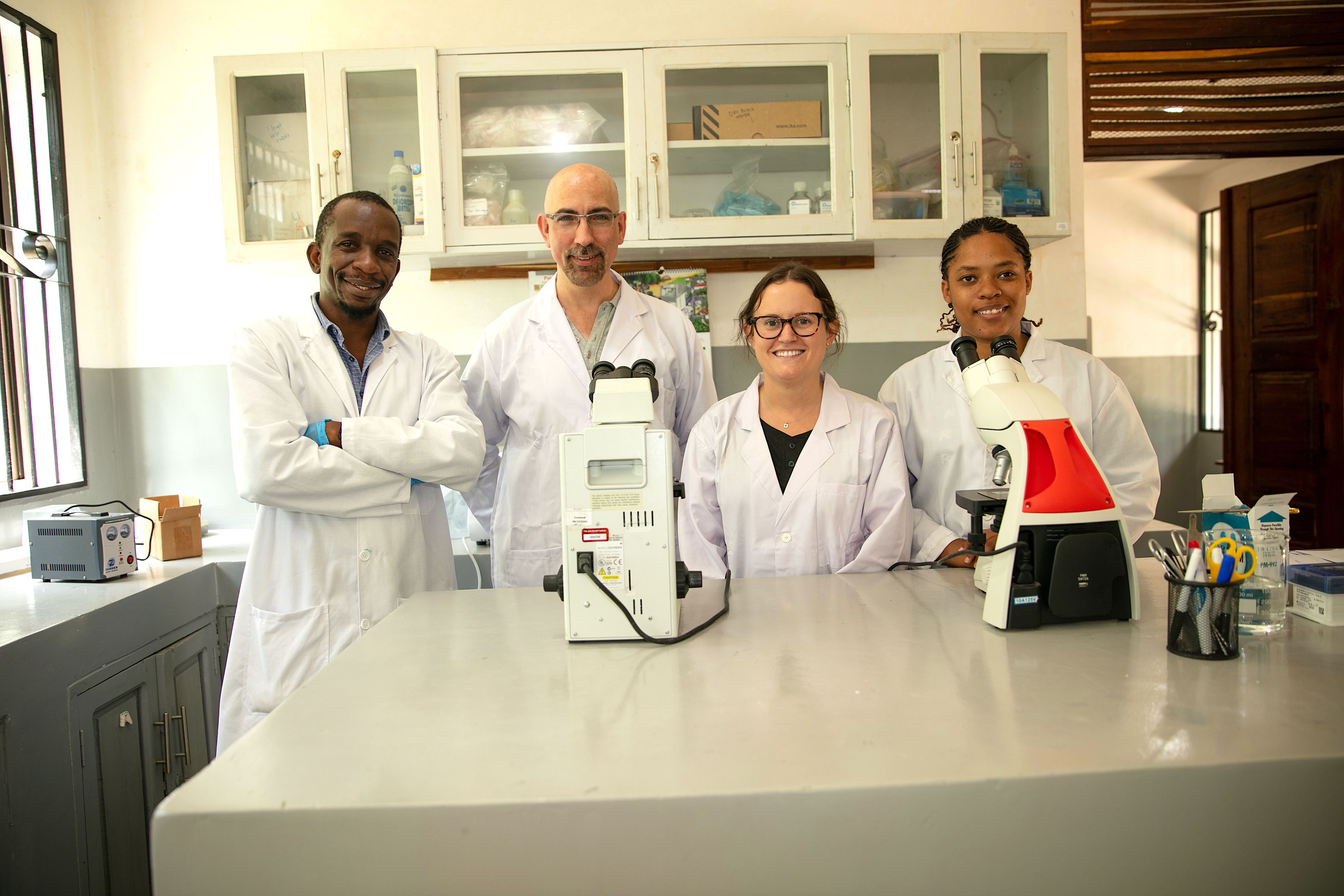
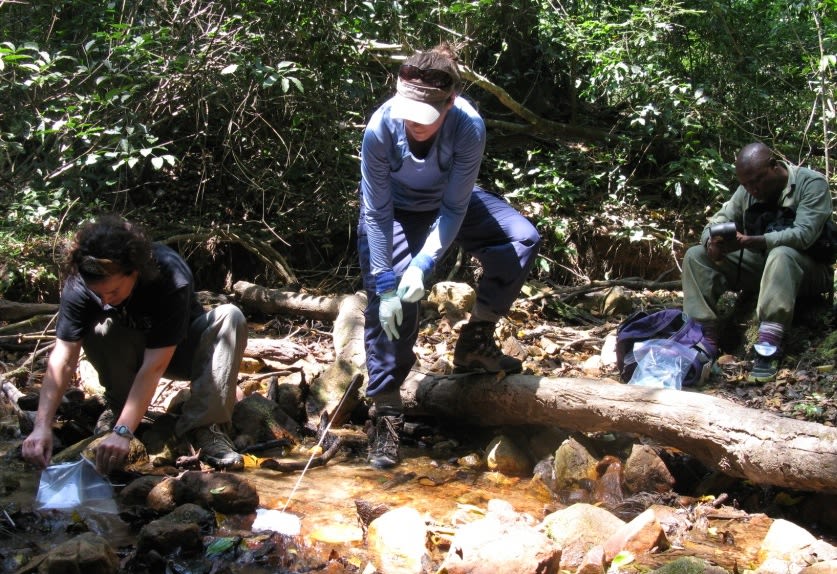
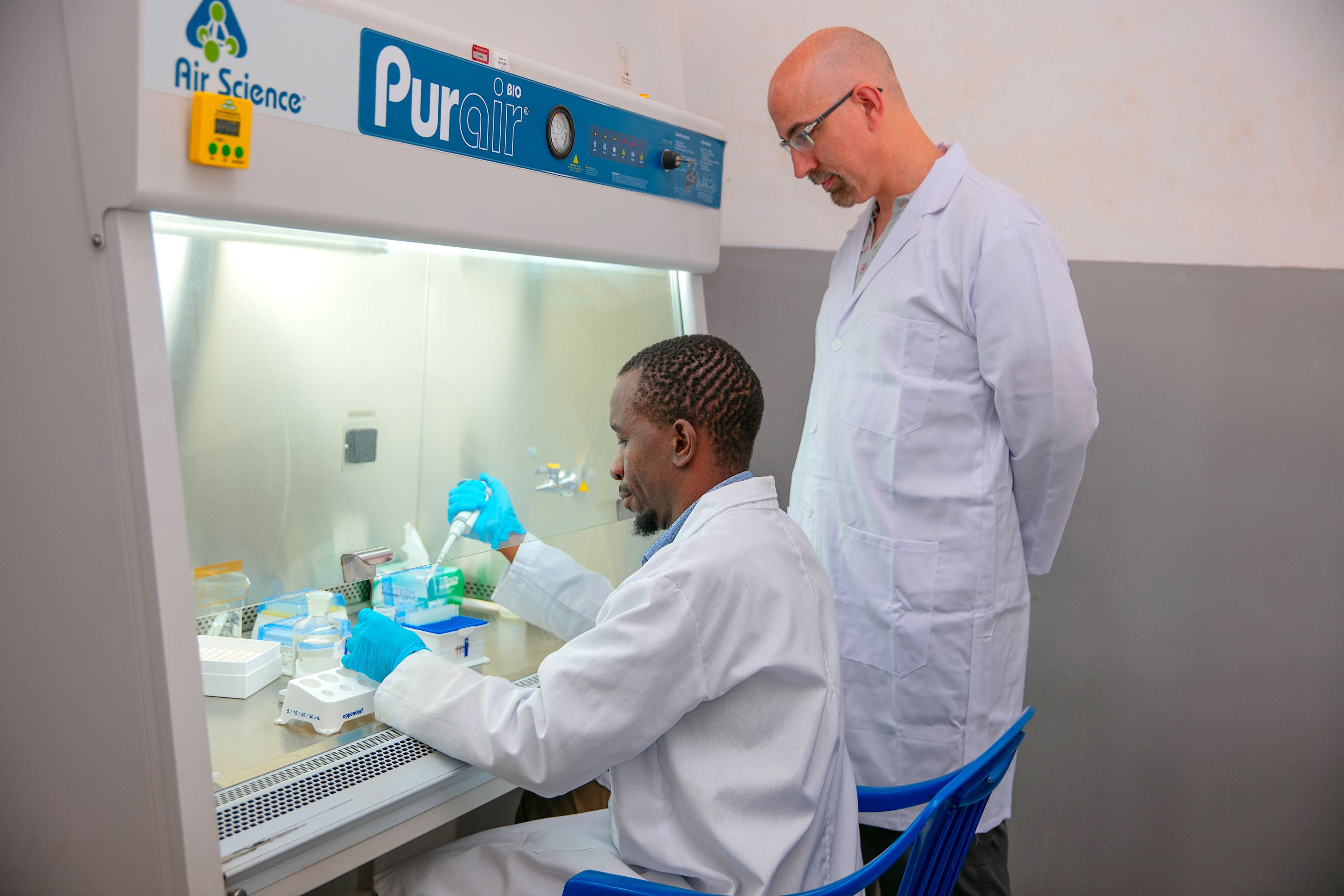
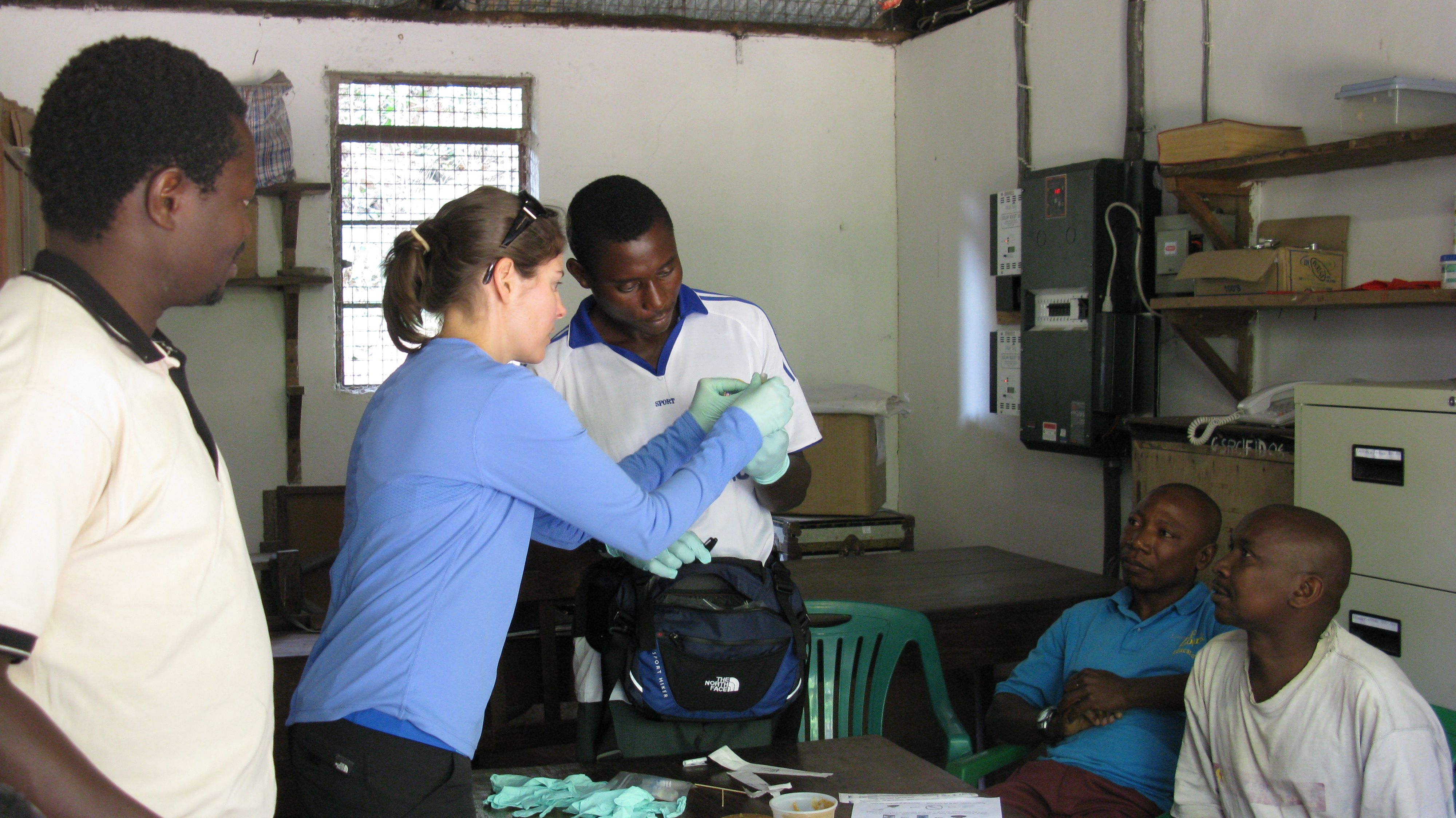

Emory students and faculty have been helping local scientists at Gombe establish an onsite laboratory for analyzing biological samples. In the center, above, are Thomas Gillespie, Emory professor of environmental sciences, next to Jessica Deere, an Emory alum and currently a postdoctoral fellow in the Gillespie lab. At far left is Dismas Mwacha, verterinarian and project manager, and at right, Priscilla Shao, laboratory technician.
Emory students and faculty have been helping local scientists at Gombe establish an onsite laboratory for analyzing biological samples. In the center, above, are Thomas Gillespie, Emory professor of environmental sciences, next to Jessica Deere, an Emory alum and currently a postdoctoral fellow in the Gillespie lab. At far left is Dismas Mwacha, verterinarian and project manager, and at right, Priscilla Shao, laboratory technician.

Gathering a sample from a stream in Gombe.
Gathering a sample from a stream in Gombe.

Thomas Gillespie, right, trains Dismas Mwacha in the technique of RNA extraction in the Gombe laboratory.
Thomas Gillespie, right, trains Dismas Mwacha in the technique of RNA extraction in the Gombe laboratory.

As an Emory graduate student, Michele Parsons, above, trained staff at Gombe to collect biological samples in the field for analysis. Parsons is now a microbiologist at the Centers for Disease Control and Prevention.
As an Emory graduate student, Michele Parsons, above, trained staff at Gombe to collect biological samples in the field for analysis. Parsons is now a microbiologist at the Centers for Disease Control and Prevention.
How do you envision your Gombe research going forward?
I’d like to further integrate strands of research I’ve been working on: Maternal-infant health and how health impacts chimpanzee development and vice-versa. How do health risks in chimpanzees change over a lifetime? Do health problems a chimpanzee may suffer in infancy affect them in the long term?
Emory recently received a $700,000 grant from the National Institutes of Health as part of a collaborative project to study chimpanzees as a model for health and aging across a lifetime.
Chimpanzees don’t go to the doctor when they are sick. They absorb their health burdens in a way that’s probably more in line with how our hominin ancestors had to deal with health insults. Research suggests, however, that chimpanzees age healthier compared to modern humans. When we age, we tend to develop diseases related to lifestyles, such as not getting enough exercise, eating too much saturated fats and experiencing excessive stress.
Wild chimpanzees don’t have these diseases of civilization. By better understanding how they naturally age, it may help us to better understand the health processes of our shared ancestry with chimpanzees versus the health processes of modern-day life.
Interview by Carol Clark
Related Stories
Human antibiotic use threatens wild chimpanzees, Valuing 'natural capital' vital to avoid next pandemic, Great apes and COVID-19: Raising the alarm for endangered species
Media contact: Carol Clark, carol.clark@emory.edu, 404-727-0501

